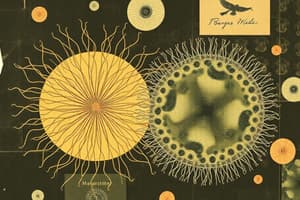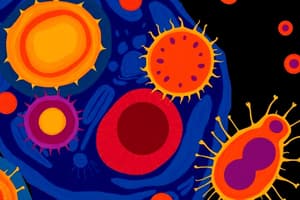Podcast
Questions and Answers
What is the origin of desmotubules and what is their diameter?
What is the origin of desmotubules and what is their diameter?
Desmotubules are derived from the smooth endoplasmic reticulum of connected cells and have a diameter of about 15 nm.
How does the cell wall contribute to a plant cell's structural integrity?
How does the cell wall contribute to a plant cell's structural integrity?
The cell wall provides mechanical strength and support, maintaining the shape and form of the cell.
Explain the role of turgor pressure in plant cells.
Explain the role of turgor pressure in plant cells.
Turgor pressure is the force exerted against the cell wall by the cell's contents, helping the plant remain rigid and erect.
In what ways do plasmodesmata facilitate communication between plant cells?
In what ways do plasmodesmata facilitate communication between plant cells?
What protective functions does the cell wall serve for plant cells?
What protective functions does the cell wall serve for plant cells?
Describe the role of the cell wall in regulating growth within plant cells.
Describe the role of the cell wall in regulating growth within plant cells.
What are the main components of the cell wall that support its functions?
What are the main components of the cell wall that support its functions?
How do microchannels in desmotubules assist in cell function?
How do microchannels in desmotubules assist in cell function?
What are integral proteins or transmembrane proteins characterized by regarding their structure and interaction with the lipid bilayer?
What are integral proteins or transmembrane proteins characterized by regarding their structure and interaction with the lipid bilayer?
How do transmembrane proteins anchor themselves to the membrane?
How do transmembrane proteins anchor themselves to the membrane?
What is the difference in solubility after dissociation for peripheral proteins compared to integral proteins?
What is the difference in solubility after dissociation for peripheral proteins compared to integral proteins?
What type of structural motifs do transmembrane proteins often form, and how does this relate to their function?
What type of structural motifs do transmembrane proteins often form, and how does this relate to their function?
What is an example of a single-pass transmembrane protein and its function?
What is an example of a single-pass transmembrane protein and its function?
How does the treatment required for integral proteins differ from that for peripheral proteins?
How does the treatment required for integral proteins differ from that for peripheral proteins?
What role does Band 3 protein play in the plasma membrane of red blood cells?
What role does Band 3 protein play in the plasma membrane of red blood cells?
What structural feature helps distinguish monotopic from polytopic transmembrane proteins?
What structural feature helps distinguish monotopic from polytopic transmembrane proteins?
What is the fundamental unit of life that makes up all living organisms?
What is the fundamental unit of life that makes up all living organisms?
Differentiate between prokaryotic and eukaryotic organisms in the context of unicellular organisms.
Differentiate between prokaryotic and eukaryotic organisms in the context of unicellular organisms.
List two main groups of unicellular organisms and provide an example of each.
List two main groups of unicellular organisms and provide an example of each.
Explain what characterizes multicellular organisms compared to unicellular organisms.
Explain what characterizes multicellular organisms compared to unicellular organisms.
What are macromolecules, and why are they important for living organisms?
What are macromolecules, and why are they important for living organisms?
Identify a multicellular organism that originates from a unicellular ancestor.
Identify a multicellular organism that originates from a unicellular ancestor.
Discuss the significance of life span as a parameter of organisms.
Discuss the significance of life span as a parameter of organisms.
Describe the relationship between macromolecules and cellular function in living organisms.
Describe the relationship between macromolecules and cellular function in living organisms.
What is the primary component of cytosol and what percentage does it make up?
What is the primary component of cytosol and what percentage does it make up?
Identify the role of cytosol in prokaryotic cells.
Identify the role of cytosol in prokaryotic cells.
How do organelles function in relation to cells?
How do organelles function in relation to cells?
Explain the contribution of mitochondria to cellular metabolism.
Explain the contribution of mitochondria to cellular metabolism.
What function does the endoplasmic reticulum serve in eukaryotic cells?
What function does the endoplasmic reticulum serve in eukaryotic cells?
Discuss the significance of dissolved ions in the cytosol.
Discuss the significance of dissolved ions in the cytosol.
What role do chloroplasts play in plant cells?
What role do chloroplasts play in plant cells?
How does the nucleus control cellular activities?
How does the nucleus control cellular activities?
What distinguishes chromatin from chromosomes in terms of structure?
What distinguishes chromatin from chromosomes in terms of structure?
Define euchromatin and heterochromatin based on their transcriptional activity.
Define euchromatin and heterochromatin based on their transcriptional activity.
What is the function of the centromere during mitosis?
What is the function of the centromere during mitosis?
What is the significance of telomeres in eukaryotic chromosomes?
What is the significance of telomeres in eukaryotic chromosomes?
How does the position of the centromere affect chromosome morphology?
How does the position of the centromere affect chromosome morphology?
In which stages of the cell cycle is chromatin predominantly decondensed?
In which stages of the cell cycle is chromatin predominantly decondensed?
What are the characteristics of the origin of replication in chromosomes?
What are the characteristics of the origin of replication in chromosomes?
Why are telomeres considered to have a high G content in their 3' strand?
Why are telomeres considered to have a high G content in their 3' strand?
Study Notes
Living Organisms
- Organisms are assemblies of molecules that function as a whole and exhibit properties of life.
- The basic unit of an organism is a cell.
- Organisms have varying lifespans.
Unicellular Organisms
- Also known as single-celled organisms.
- They are the most primitive form of life.
- The main groups include bacteria, archaea, protozoa, algae, and fungi.
- They are categorized as prokaryotic or eukaryotic based on cellular organization.
- They are often microscopic.
- Examples include:
- Bacteria like Escherichia coli, Mycobacteria, Bacillus sp.
- Protozoans like Amoeba, Paramecium
- Algae like Chlorella sp, Chlamydomonas, Diatoms, Euglenophyta, Dinoflagellates
- Fungi like yeast
Multicellular Organisms
- Consist of many cells specialized for different functions.
- Most bacteria are unicellular, but some species like Myxobacteria and Spirogyra are multicellular.
- Most eukaryotic organisms are multicellular.
- They have well-developed body structures and specific organs for specific functions.
- Most plants and animals are multicellular.
- All animals are eukaryotic and most are multicellular.
Plasmodesmata Structure
- Desmotubules are derived from the smooth endoplasmic reticulum of connected cells.
- Their diameter is about 15 nm.
- They are used to transport lipid molecules.
Plant Cell Wall Functions
- Forms a framework for the cell.
- Provides mechanical strength and support.
- Controls the direction of cell growth.
- Withstands turgor pressure.
- Regulates cell growth.
- Regulates diffusion.
- Facilitates communication between cells.
- Provides protection against pathogens.
- Stores carbohydrates.
- Resists shear stress.
Transmembrane Proteins
- Integral proteins embedded within the phospholipid bilayer.
- Non-polar amino acid residues with hydrophobic side chains interact with the fatty acyl groups of membrane phospholipids.
- They are characterized by 21-26 hydrophobic residues coiled into an α-helical structure spanning the lipid bilayer.
- They can be single pass (monotopic) or multi-pass (polytopic).
- Glycophorin is a single pass transmembrane protein with 131 amino acid residues, carrying sugar molecules.
- Band 3 protein/chloride-bicarbonate exchanger is a multi-pass membrane protein for chloride and bicarbonate exchange.
Plasma Membrane Proteins
- Peripheral proteins can be released via mild extraction processes.
- Integral proteins require strong hydrophobic bond breaking agents for release.
Cytosol
- The liquid-like portion of the cytoplasm.
- Composed mostly of water, dissolved minerals, and cytoskeleton filaments.
- Doesn't contain organelles but holds them within the cell.
- Contains water, organic molecules, and dissolved ions.
- The highest percentage of cytosol component is water (about 70%).
- Typical ions include potassium, magnesium, calcium, sodium, chloride, bicarbonate, and amino acids.
- It's the site of many chemical reactions.
- In prokaryotes, most metabolic reactions occur in the cytosol.
- In eukaryotes, it's where organelles are suspended.
- It plays a role in osmoregulation and cell signaling.
- Involved in generating action potentials in cells like nerve and muscle cells.
Cell Organelles
- Specialized structures within cells that perform specific tasks.
- In eukaryotic cells, the nucleus contains genetic material and controls cell activities.
- Chloroplasts are plastids containing green pigments essential for photosynthesis.
- Mitochondria synthesize energy for numerous metabolic processes.
- The endoplasmic reticulum is an interconnected network involved in lipid synthesis, carbohydrate metabolism, drug detoxification, and attachment of receptors on cell membrane proteins.
Chromatin and Chromosome
- Chromatin is an organized structure of DNA and protein found in the nucleus of eukaryotic cells.
- Chromatin and chromosomes are essentially the same; chromatin is less condensed DNA, chromosomes are highly condensed.
- Chromosomes are named for their ability to stain strongly with particular dyes.
- The level of chromatin condensation varies during a cell's life cycle.
- Euchromatin is less condensed, light-staining, transcriptionally active.
- Heterochromatin is highly condensed, dark-staining, generally transcriptionally silent.
Centromere
- The constricted region of linear chromosomes.
- Usually located in the center of the chromosome.
- Serves as the site of association of sister chromatids and as the attachment sites for microtubules of the mitotic spindle.
Telomere
- Specialized structures that cap the ends of eukaryotic chromosomes.
- Consist of a long array of short, tandemly repeated sequences.
- Most telomeres have repetitive sequences with a high G content in the strand with its 3' end.
Origin of Replication
- The sequence in a chromosome where replication initiation occurs.
Studying That Suits You
Use AI to generate personalized quizzes and flashcards to suit your learning preferences.
Related Documents
Description
Explore the fascinating world of living organisms in this quiz. Learn about unicellular and multicellular organisms, their structures, and classifications. Test your knowledge on different life forms, their characteristics, and examples.




